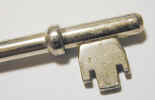 Cryptography has had a long and colourful history. The earliest forms of secret writing required only pen and paper, and are now collectively termed classical cryptography. The two main categories are transposition ciphers, which rearrange the order of letters in a message, and substitution ciphers, which systematically replace groups of letters with others. Classical ciphers tend to leak varying amounts of information about the statistics of the plaintext, and because of this they are easily broken, for example by frequency analysis. Classical ciphers still enjoy popularity today, though mostly as puzzles (see cryptogram). Cryptography has had a long and colourful history. The earliest forms of secret writing required only pen and paper, and are now collectively termed classical cryptography. The two main categories are transposition ciphers, which rearrange the order of letters in a message, and substitution ciphers, which systematically replace groups of letters with others. Classical ciphers tend to leak varying amounts of information about the statistics of the plaintext, and because of this they are easily broken, for example by frequency analysis. Classical ciphers still enjoy popularity today, though mostly as puzzles (see cryptogram).
 E arly in the 20th century, several mechanical devices were invented for performing encryption, including rotor machines - most famously the Enigma cipher used in World War II. The ciphers implemented by these machines brought about a significant increase in the complexity of cryptanalysis. The various attacks on Enigma, for example, succeeded only after considerable effort. Occasionally, these devices have featured in films, such as in the James Bond adventure From Russia with Love.
. E arly in the 20th century, several mechanical devices were invented for performing encryption, including rotor machines - most famously the Enigma cipher used in World War II. The ciphers implemented by these machines brought about a significant increase in the complexity of cryptanalysis. The various attacks on Enigma, for example, succeeded only after considerable effort. Occasionally, these devices have featured in films, such as in the James Bond adventure From Russia with Love.
.
 With the advent of digital computers and electronics, very complex ciphers could be implemented. A characteristic of computer ciphers is that they operate on binary strings unlike classical and mechanical schemes, which use an alphabet of around 26 letters, depending on the language. Computer ciphers are also much more resistant to cryptanalysis; few are susceptible to a ciphertext-only attack. With the advent of digital computers and electronics, very complex ciphers could be implemented. A characteristic of computer ciphers is that they operate on binary strings unlike classical and mechanical schemes, which use an alphabet of around 26 letters, depending on the language. Computer ciphers are also much more resistant to cryptanalysis; few are susceptible to a ciphertext-only attack.
 E xtensive academic research into modern cryptography is relatively recent — it only began in the open community during the 1970s with the specification of DES and the invention of RSA. It is well that much progress has been made in a short time; popular applications such as the Internet and mobile phones have repositioned cryptography, historically the sole province of a few groups with exceptional needs for secrecy, into a mainstream technology on which millions rely. E xtensive academic research into modern cryptography is relatively recent — it only began in the open community during the 1970s with the specification of DES and the invention of RSA. It is well that much progress has been made in a short time; popular applications such as the Internet and mobile phones have repositioned cryptography, historically the sole province of a few groups with exceptional needs for secrecy, into a mainstream technology on which millions rely.
 As well as noting lessons from its history, cryptographers are also careful to consider the future. Moore's law is routinely taken into account when specifying key-lengths, and the potential effects of quantum computing have already been considered. Note also quantum cryptography. As well as noting lessons from its history, cryptographers are also careful to consider the future. Moore's law is routinely taken into account when specifying key-lengths, and the potential effects of quantum computing have already been considered. Note also quantum cryptography.
 SCryptography is commonly used for securing communications. Four desirable properties are:
Confidentiality, also known as secrecy: only an authorised recipient should be able to extract the contents of the message from its encrypted form. Otherwise, it should not be possible to obtain any significant information about the message contents.
Integrity: the recipient should be able to determine if the message has been altered during transmission.
Authentication: the recipient should be able to identify the sender, and verify that the purported sender actually did send the message.
Non-repudiation: the sender should not be able to deny sending the message. SCryptography is commonly used for securing communications. Four desirable properties are:
Confidentiality, also known as secrecy: only an authorised recipient should be able to extract the contents of the message from its encrypted form. Otherwise, it should not be possible to obtain any significant information about the message contents.
Integrity: the recipient should be able to determine if the message has been altered during transmission.
Authentication: the recipient should be able to identify the sender, and verify that the purported sender actually did send the message.
Non-repudiation: the sender should not be able to deny sending the message.
Cryptography can provide mechanisms to help achieve all of the above. However, some goals aren't always necessary, practical or even desirable in some contexts. For example, the sender of a message may wish to remain anonymous; clearly non-repudiation would be inappropriate in that case.
|


 Cryptography has had a long and colourful history. The earliest forms of secret writing required only pen and paper, and are now collectively termed classical cryptography. The two main categories are transposition ciphers, which rearrange the order of letters in a message, and substitution ciphers, which systematically replace groups of letters with others. Classical ciphers tend to leak varying amounts of information about the statistics of the plaintext, and because of this they are easily broken, for example by frequency analysis. Classical ciphers still enjoy popularity today, though mostly as puzzles (see cryptogram).
Cryptography has had a long and colourful history. The earliest forms of secret writing required only pen and paper, and are now collectively termed classical cryptography. The two main categories are transposition ciphers, which rearrange the order of letters in a message, and substitution ciphers, which systematically replace groups of letters with others. Classical ciphers tend to leak varying amounts of information about the statistics of the plaintext, and because of this they are easily broken, for example by frequency analysis. Classical ciphers still enjoy popularity today, though mostly as puzzles (see cryptogram).
 E xtensive academic research into modern cryptography is relatively recent — it only began in the open community during the 1970s with the specification of DES and the invention of RSA. It is well that much progress has been made in a short time; popular applications such as the Internet and mobile phones have repositioned cryptography, historically the sole province of a few groups with exceptional needs for secrecy, into a mainstream technology on which millions rely.
E xtensive academic research into modern cryptography is relatively recent — it only began in the open community during the 1970s with the specification of DES and the invention of RSA. It is well that much progress has been made in a short time; popular applications such as the Internet and mobile phones have repositioned cryptography, historically the sole province of a few groups with exceptional needs for secrecy, into a mainstream technology on which millions rely.